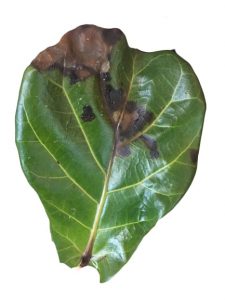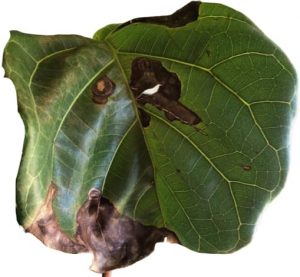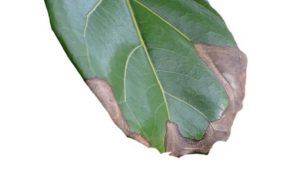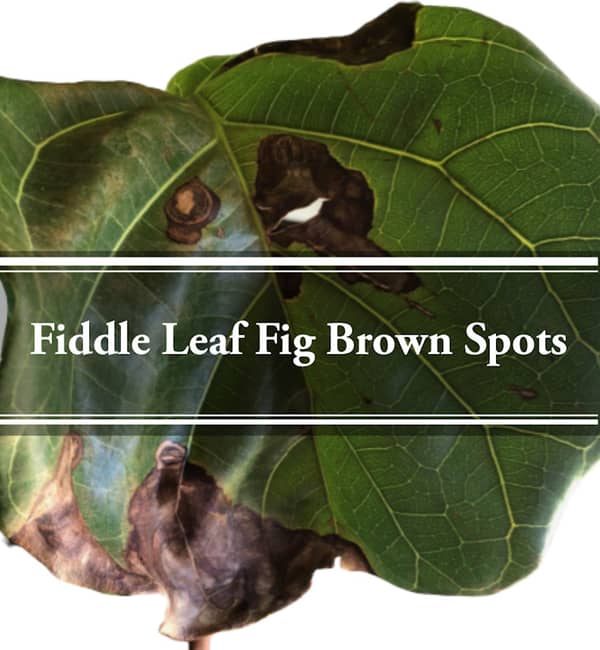Ficus Lyrata, commonly known as Fiddle-leaf figs are flowering species belonging to the Moraceae family. These natives of Western Africa can reach up to a height of 50 feet. The main features of the plant include the shiny lush green foliage, compact spread, and suitability for both indoor and outdoor environments. These plants are quite resistant. However, a common issue faced in their growth is known as Fiddle leaf fig brown spots.
Fiddle leaf fig brown spots can be of different nature, sizes and causes. Consequently, they need different treatments. To combat the brown spots on fig leaves, you need to examine the plant closely and check for its requirements. Let us have a look at the possible symptoms and causes of the fig tree leaves turning brown along with the possible treatments.
Requirements of the Fiddle Leaf Plant
The basic requirements of the plant include;
- Bright indirect light.
- Watering after the soil gets dry.
- Well-drained soil.
- Temperature between 45 and 95 °F.
- Humidity and aeration.
Any disturbance in the essentials of the plant disturbs the health of the plant.
Causes of brown spots on fiddle leaves
The four basic causes are as under;
- Fungal Root rot.
- Bacterial Infection.
- Plant Dryness.
- Pest attack.
Check for the size, color, and place of these spots. Moreover, you need to have a look at the watering routine and sunlight availability of your tree. Once the nature and causes of the browning are observed, follow the appropriate treatment to make your plant peep healthy again. Let us have a look at all of the reasons in detail.
Fiddle Leaf Fig Brown Spots Due to Root Rot

The fiddle fig plant needs the soil to dry out between the watering. Poor drainage of soil and over-watering causes fungal infection in the roots. This infection travels all the way upward to your plant and starts infecting the leaves. The infected leaves will slowly turn brown and fall off or die eventually.
How to check for the root rot
- Now, the question arises about how to know if the plant is actually suffering from root rot. This can be checked by two methods. The first one is to take the plant out of the pot to have a clear look at the root. Brown and mushy roots are an indication of rotting.
- If the rotting and browning of spots are just at the initial stage, better to avoid repotting. Simply lookout for the symptoms or use a moisture meter if it indicates higher levels of wetness.
Symptoms
The two main symptoms of root rot due to fungal infection are;
- Older leaves are more susceptible to Browning due to root rot. The fresher leaves are usually a secondary target. Thus, if the leaves on the lower sides of the stem are getting small black spots getting large and brown, you can blame it to root rot.
- The other possible symptom is the falling of leaves. If the spotting of leaves is eventually making them fall out, this is another sign of the infected roots.
Thus, if the leaves are getting spotted and falling if, starting from the older ones, you need to check the plant for root rot.
Solution
Simply look at your watering routine and the availability of sunlight for the plant. The well-drained potting mix and pot, well-lit space, and letting the soil dry out between consecutive watering is essential to keep root rot at a bay.
Repotting
In case of a severe attack; just take the plant out of the pot. Cut the mushy roots and leaves and repot the plant. Place it in a well-lit place and without water for about 2 weeks. Make sure you avoid over-watering and poor drainage in the future.
Without Repotting
If the small brown spots on the fiddle leaf fig have just started, you can deal with the plant while keeping it potted. Just cut the spotted leaves and place them in a well-lit space. Withdraw the water for two or more weeks until the soil and the roots get dry. Use a moisture meter to check if the roots have turned dry. No further spotting in leaves is a sign of successful treatment.
Medicinal Treatments
There are many medicated treatments available in markets to combat the root rot issue. You can get some consultation and use it according to the condition of the plant.
Fiddle Leaf Fig Brown Spots Due to Bacterial Infection

Another possible reason for the fiddle fig leaves turning brown is due to bacterial infection. This is no doubt a stubborn enemy for your fiddle plant. If the plant is not responding to the treatment for the fungal infections, it is possibly a sign of bacterial infection.
Symptoms
- Bacterial infections are most common in plants bought from big-box stores.
- If you are not over-watering the plant and treatments of root rot are not showing effect, you need to blame the nasty bacteria.
- The main symptom of bacterial infection is their color and location. They appear in the brown shade in a spreading manner. Moreover, they can occur anywhere the leaf from the middle to the edges. This is unlike the black and brown small spots in the fungal infection.
- The bacterial spots affect the plant body. This includes both older and younger leaves. However, this is more destructive for the new leaves which start by showing slow or stunted growth.
- One foolproof sign of a bacterial attack is the yellowing of leaves. On the other hand, the fungal infection is shown by dark black and brownish starting from the edges of the dark green leaves.
- All this spotting will eventually cause the leaf to fall off just like the fungal spots.
Solution
Treatment without Repotting
It would be best to pay attention to the plant and start combating the disease in the early stage before it spreads. Simply cut the affected leaves. Importantly, let the soil dry out between consecutive watering and place the plant in good indirect sunlight.
Placing the Plant Outdoor
It would be great if you place the plant outdoor in indirect sunlight. This will ensure plenty of light and aeration for the plant. Make sure to avoid direct sunlight. Moreover, the temperature should remain between 50 to 95 °F. Any temperature crossing the range will be harmful to the plant.
Treatment by Repotting
In the case of severity, the treatment is pretty similar to the fungal root rot. You can repot the plant using a fertile potting mix. Remove the bad roots and leaves before repotting.
Medicinal Treatment
You can get suitable antibacterial medicine to treat the plant. These are available in both powdered and liquid forms.
If the plant has more than half of the foliage eaten up, it is best to get a new plant.
Fiddle Leaf Fig Brown Spots Due to Dryness

If you have neglected the plant and missed watering recently, dryness is the culprit. Keeping the plant at high temperature and low humidity may also result in the drying of foliage.
Symptoms
- The edges of the leaves are turning light brown and crispy.
- The plant looks dry, wrinkled, and unfresh.
- The soil gets dry and shrinks in the pot. This prevents the water from reaching the root ball. This, if you skip a few weeks of watering, the soil gets dry and does not let the roots soak the water even if you are watering.
Solution
Watering
Water and mist the plant to provide adequate moisture.
Soil Treatment
Mulch the soil mildly to break the soil. This will let the water reach the roots. Or you cancan repot the plant to solve this issue.
Adequate Humidity
Make sure you provide adequate moisture to the plant. On dry days, consider misting every other day or whenever the plant looks dry. There should be enough aeration to let the foliage dry. Moreover, you can use a humidifier in the surrounding.
Proper Care
Once the plant gets healthy again, make sure you water regularly right after the soil gets dry.
Fiddle Leaf Fig Brown Spots Insect Infestations

Small brown spots on the fiddle leaf plant which turn into tiny holes later are surely due to insect infestations. These spots can be either reddish or black in color. You can have a closer look at the plant to check out for pests. These initial attacks of these mites are the young and tender leaves and later spread to the whole plant. Use a magnifying glass to inspect the plant. However, insect attack is quite rare in these plants.
Symptoms
- If there are white or grey small web-like structures on the leaves, these are spider mites. These will reproduce at a larger scale to harm the plant.
- There can be other mites as well like mealy bugs etc.
Treatments
Neem Oil
There are different treatments for these bugs. Mild spraying of pure Neem oil spray is the natural remedy to combat this issue. However, this spray is quite smelly.
Pesticides
Markets are full of different varieties of insecticides and pesticides. You can select according to your requirement.
Water Spray
Strong water spray on the foliage helps to remove these mites. However, make sure the contaminated water does not run into other plants to contaminate them.
Manual removal
It is always better to grab the issue in the initial stage. If you are dealing with a single plant, you can manually remove the webs and mites with cotton or neem oil. Just dip the cotton in neem oil simple wet cotton to squish away the webs and the mites.
Summary
Fiddle leaf fig leaves turning brown is a common issue. However, these spots can be due to different reasons. The most common reason is the fungal attack on roots which affects the foliage.
- Small brown or black spots on the leaves starting from the older leaves are a possible result of overwatering and poor drainage. This issue can be solved by cutting the bad leaves and roots after repotting. Moreover, you can simply let the plant dry out by withdrawing the water for two or more weeks.
- If the fig tree leaves are turning brown from the edges with expanded spotting with yellowing of leaves, this can be due to bacterial invasion. This attacks all the leaves of the plant and is quite resistant to common treatments. A commonly available bactericide or repotting can help you out.
- The fiddle fig brown spots of an under-watered plant starting from the edges making the leaves crispy is due to dryness. Proper water, repotting and adequate moisture do the job.
- The cause of fiddle leaf brown spots turning into tiny holes is pest infestation. Inspect the plant for pests and their webs. This issue can be solved by neem oil, manual squishing, water spraying, or a commonly available pesticide.

